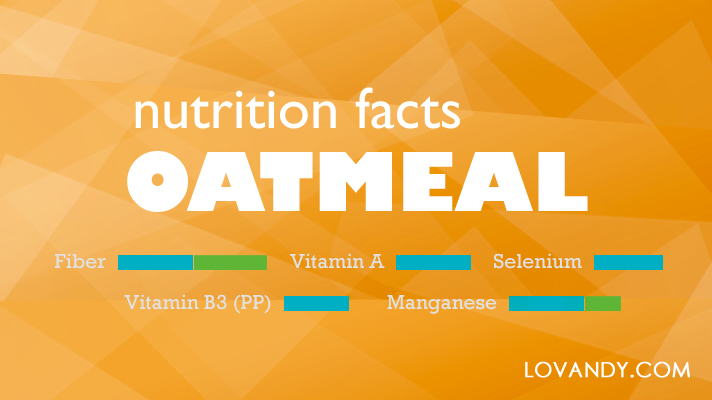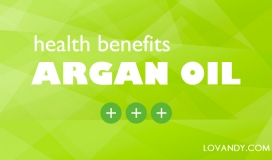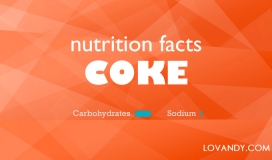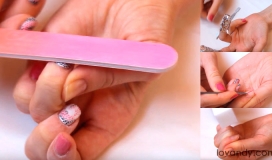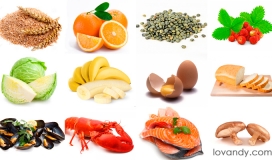Oatmeal is one of the most health beneficial products. This cereal is known everywhere. There are many international cuisines where this component is being widely used. Let us find out more information about the nutrient content of oatmeal!
Any cereal is good for your health. However, oatmeal is a product you remember to have been eating since your earliest childhood. Why so? Well, oat itself is an extremely powerful source of nutrients. We are talking here about many and many vitamins (such as A, K, E, B group) and microelements (potassium, calcium, sodium etc.) Nevertheless, before we start talking about the content of these, let us consider what instant oatmeal is.
- Instant Oatmeal Nutrition Facts
- Raw Coarse Oatmeal Nutrition Facts
- Vitamins and Minerals in Oatmeal
- How Many Carbohydrates Does Oatmeal Contain?
- Glycemic Index of Oatmeal
- How Much Protein is There in Oatmeal?
- How Much Fiber is in Oatmeal?
- How Much Sugar Does Oatmeal Contain?
- Nutrition Facts of Coarse and Instant Oat
Instant Oatmeal Nutrition Facts
The shell of oat grain contains most of biologically active substances and vitamins. When making instant porridges, manufacturers clean, polish, crush and process all these grains with high pressure and steam. This is done for cereal to be easy and fast cooked. Of course, such actions lead to losing almost all beneficial elements and vitamins. However, instant oatmeal does contain a lot of converted starch, which is actually bad. Your body will assimilate it immediately and then convert into sugar.
Everything said does not mean you should not eat instant oatmeal at all. The thing is you will not get as much vitamins as you would from a regular oat. However, it is much better to grab some instant cereal than any fast food. Just be careful with the amount of sugar, especially if you are on a diet.
Quaker Instant Oatmeal Nutrition
Quaker oatmeal is one of the most popular instant cereals around the globe. Therefore, you should know something about its content. Truth be said, this brand is not much different from any other. However, talking about vitamins, Quaker instant oatmeal has a nice percentage of group B, comparing to other brands. There is also an average amount of potassium and sodium in there. In general, Quaker oatmeal contains 5 times less minerals and vitamins than raw oat, which is actually a good mark.
Raw Coarse Oatmeal Nutrition Facts
Now, as we have considered all about instant products, let us find out how healthy raw oat is. Oatmeal contains natural antioxidants, which increase the resistance of your body to negative effects of environment. Calcium and phosphorus in oatmeal are necessary for the development of the human bone system, and a large amount of iron makes oatmeal a useful food for the prevention of anemia.
Dishes from oats are dietary, because body absorbs them very easily. The grains of this cereal contain an enzyme that helps in the breakdown of carbohydrates, as well as substances called thyrosteatins, which contribute to the normal functioning of the thyroid gland. Nutritionists advise eating oatmeal in the morning – this is an easy and nutritious dish. High vitamins and minerals capacity makes it an ideal breakfast.
Vitamins and Minerals in Oatmeal (Calcium, Manganese, Vitamin A)
Oatmeal contains many microelements and vitamins that normalize metabolism. It does not matter, how fit and healthy you are. One bowl of oat with milk is always a nice idea! Why? Look at all these vitamins below.
Vitamin B normalizes the process of digestion of food, positively affects the skin. That is why doctors recommend oatmeal as one of the main dishes for people with dermatitis or allergies.
Phosphorus and calcium strengthen the bone system, hair roots and the nail plate. Here, the use of oatmeal is obvious for people suffering from the pathology of musculoskeletal system.
Oatmeal also contains a lot of iodine, which helps with mental development. Vitamins A and E are useful for your beauty.
Potassium and magnesium relieve muscle fatigue; these elements are necessary for those who suffer from muscle contraction. K vitamin, which oatmeal is filled with, is involved in work of kidneys, liver, gall bladder. It helps your body to assimilate calcium, provides a normal interaction of calcium and vitamin D.
Therefore, speaking of vitamins and microelements content, oatmeal is something indispensable. Of course, there are many other products that may have the same amount of nutrients, but none of them is absorbed so easily. Which makes oat an absolute health beneficial leader.
| Name of nutrition component | Content in raw oat per 100 g | Content in Quaker oat per 100 g | Percent of daily norm |
|---|---|---|---|
| Vitamin A | 1.072 mg | 191 µg | 20.1% |
| Vitamin B1 | 2.05 mg | 0.18 mg | 12.3% |
| Vitamin B2 | 1.2 mg | 0.21 mg | 10.5% |
| Vitamin B3 (PP) | 16.55 mg | 2.44 mg | 16.3% |
| Vitamin B5 | 1.1 mg | 0.15 mg | 15.2% |
| Vitamin B9 (folic acid) | 286 µg | 53 µg | 3.3% |
| Vitamin E | 0.47 mg | 0.13 mg | 1.3% |
| Vitamin K | 1.9 µg | 0.7 µg | varies |
| Potassium | 358 mg | 78 mg | 2.2% |
| Calcium | 353 mg | 64 mg | 10.1% |
| Magnesium | 137 mg | 27 mg | 9.7% |
| Sodium | 279 mg | 158 mg | 3.8% |
| Phosphorus | 423 mg | 97 mg | 16.1% |
| Iron | 29.27 mg | 2.4 mg | 4.8% |
| Manganese | 2.94 mg | 0.87 mg | 29.1% |
| Copper | 0.375 mg | 0.07 mg | 2.8% |
| Zinc | 3.55 mg | 0.61 mg | 4.0% |
| Selenium | 26.8 µg | 6.7 µg | 17.7% |
How Many Carbohydrates Does Oatmeal Contain?
Oatmeal is a very nutritious product. This means it should contain a big amount of carbs. Well, that is true; half of one grain of oat is actually carbohydrates. Such number is really huge, especially for those who tries to lose weight. However, you still can eat a lot oatmeal, because, when cooked with milk, this amount is decreased by three. If you use water instead and put no sugar, consider it to be four times less. Find out more about oatmeal calories here.
Carbohydrates are an excellent source of energy for your body. The benefit of oatmeal is that complex carbohydrates provide the body with cheerfulness and energy until the end of a day.
Glycemic Index of Oatmeal (Cooked, Raw)
When talking about glycemic index, products can be split into groups with high, medium and low values. Plain oat is located in the last group, with the index of 40. However, nobody eats oat just as is. And glycemic index of cooked oatmeal is actually different.
Oatmeal on water is the most valuable meal for those who go on a diet. Therefore, you should know that this product is located at the middle group. The glycemic index of such oatmeal is 60.
If you cook your oatmeal on milk, the index of such meal will not actually be different. It is like 5 values more or less. The thing is lactose has almost the same glycemic index as oat does.
Instant oatmeal (let us take Quaker one for the example) as you know, has nothing to be compared with natural one. However, the glycemic index of any Quaker meal is 66, which is almost the same.
How Much Protein is There in Oatmeal?
The percentage of protein for uncooked oat is somewhat 10-15. This cereal is not a protein-filled thing. However, all those vitamins we have mentioned before help this protein to be absorbed real quick. That is why sportsmen use oatmeal for breakfast. It gives you an energy you need, leaving nothing behind.
By the way, there are almost no fats in oat. It is like 5-7 percent for raw grains. And if you cook it with water, this number strives to zero.
How Much Fiber is in Oatmeal?
Cellulose is a construction material for your muscles. Combined with vitamins and proteins, it helps your body to stay toned during exercises. This way, you have a lot of energy for sport, and none of it is wasted. There is something of 10% of fiber in raw oat grains.
As we have mentioned before, instant oatmeal contains a lot of starch, which is converted to sugar fast. Therefore, deny using it if you are trying to lose weight, and eat less if you do sport.
How Much Sugar Does Oatmeal Contain?
As we have said, carbohydrates are most part of oat. Does this mean it contains a lot of sugar? Yeah, but this sugar is just fructose and sucrose that are actually good for health. The thing is these elements do not convert into fats, when not needed. Therefore, your body gets a lot of instant energy, when you eat oatmeal. This energy should we used somewhere, but if it is not, there is no big deal.
However, you should not eat too much oat if you do not exercise. This may lead to calcium leaching out of bone tissues due to a high content of phytic acid in your blood.
Nutrition Facts of Coarse and Instant Oat
| Name of nutrition component | Content in raw oat (100 g) | Content in oat with milk (100 g) | Content in oat with water (100 g) | Percent of daily norm (for 100 g on water) |
|---|---|---|---|---|
| Proteins | 11.1 g | 3.3 g | 3.1 g | 3.4% |
| Fats | 6.2 g | 3.9 g | 1.8 g | 2.1% |
| Carbohydrates | 65.5 g | 14.3 g | 15.1 g | 3.7% |
| Fiber | 10.2 g | 4.4 g | 4.7 g | 39.1% |
Here is the table of nutrients for Quaker instant oatmeal.
| Name of nutrition component | Content in raw oat (100 g) | Content in oat with milk (100 g) | Content in oat with water (100 g) | Percent of daily norm |
|---|---|---|---|---|
| Proteins | 2.67 g | 0.79 g | 0.75 g | 0.8% |
| Fats | 1.7 g | 1.08 g | 0.7 g | 0.5% |
| Carbohydrates | 22.3 g | 4.87 g | 5.15 g | 1.2% |
| Fiber | 2.1 g | 0.91 g | 0.97 g | 8.1% |
Oatmeal is one of the most useful products. It is not only tasty, but also very beneficial for your health. It is recommended to consume some oatmeal 2-3 days a week for breakfast. This way you will fill your body with energy and vitamins, making it ready for any kind of exercise or brainwork. By the way, oat is one of the products, completely studied by scientists, meaning it is absolutely nice.

